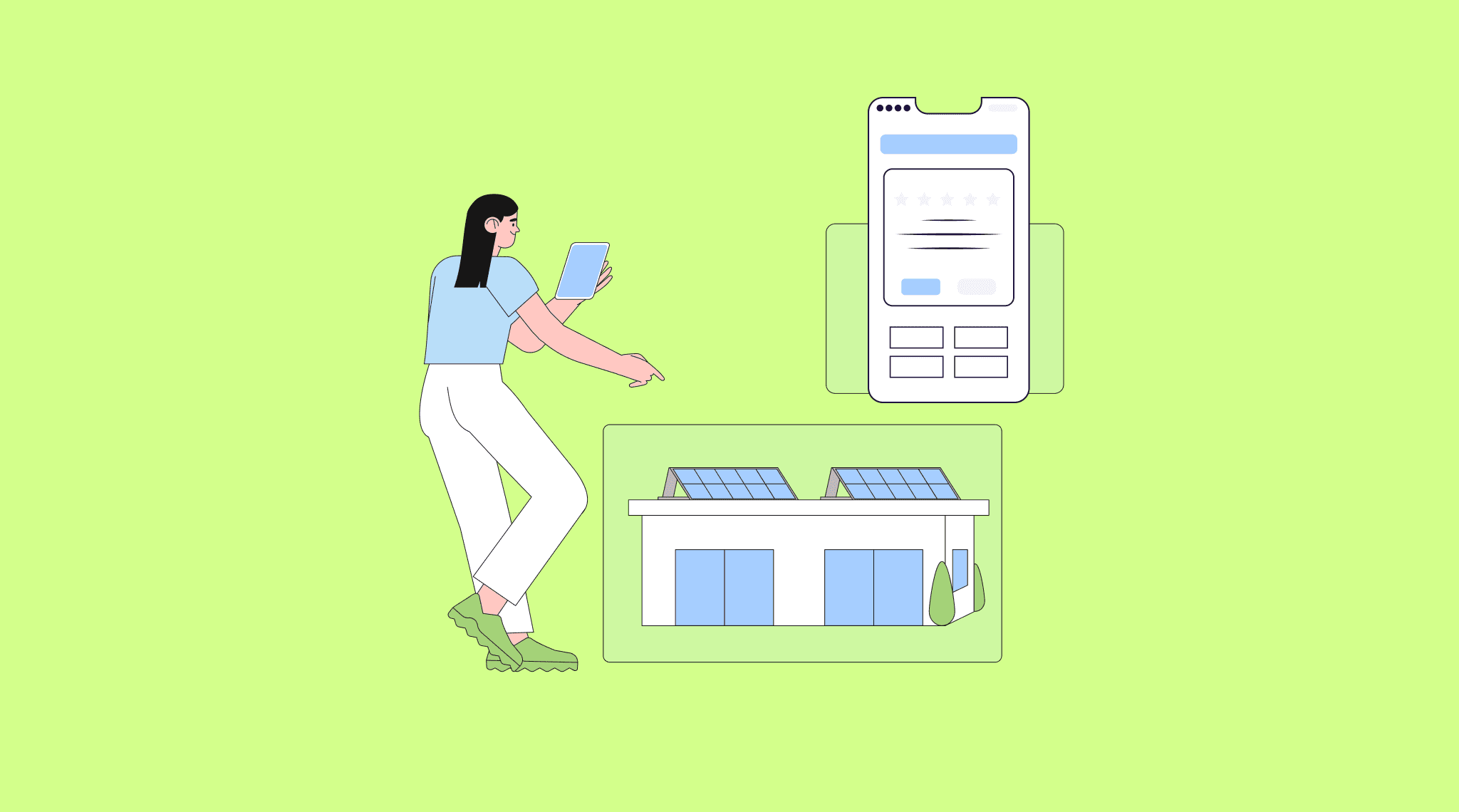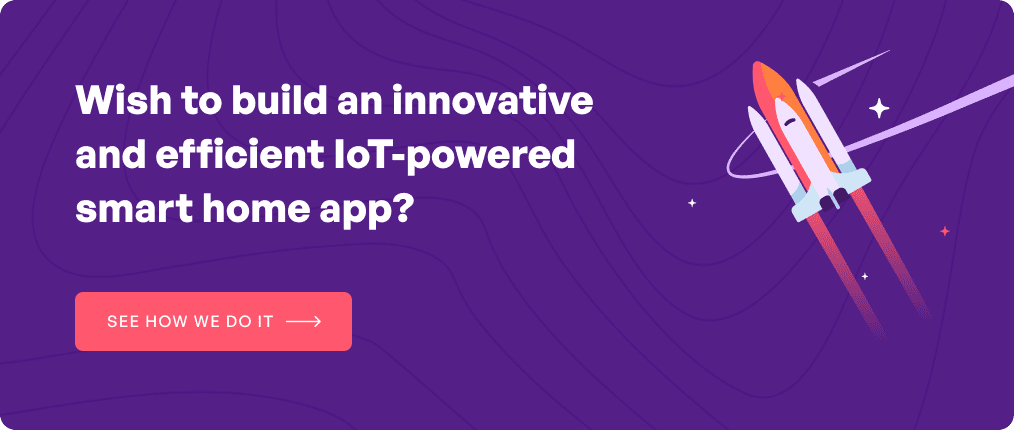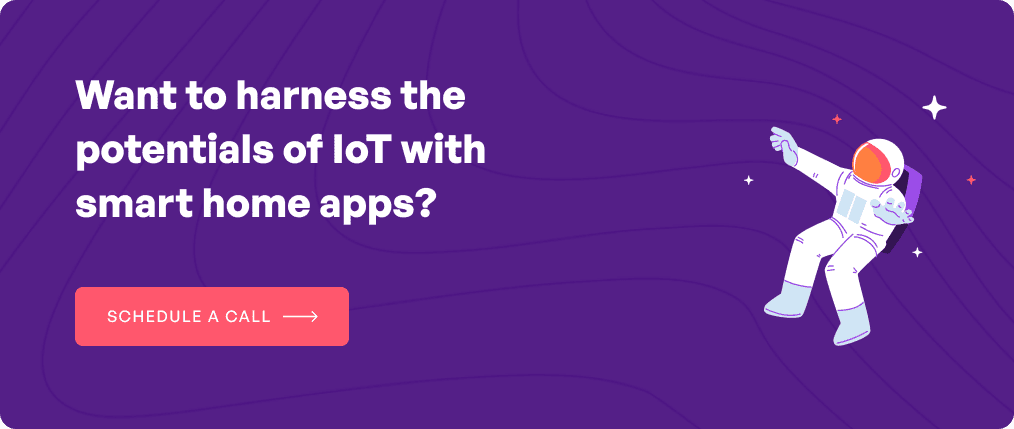A smart home app uses IoT technology to remotely control and manage household features and appliances like thermostats, lights, smart locks, smoke detectors, sprinkler systems, and security cameras. The concept brought a whole new era of customization, convenience, and comfort on users’ fingertips. While this is nothing new, smart home automation solutions play a pivotal role in helping companies, especially startups, to make their mark in a thriving market and save users’ time, effort, and money.
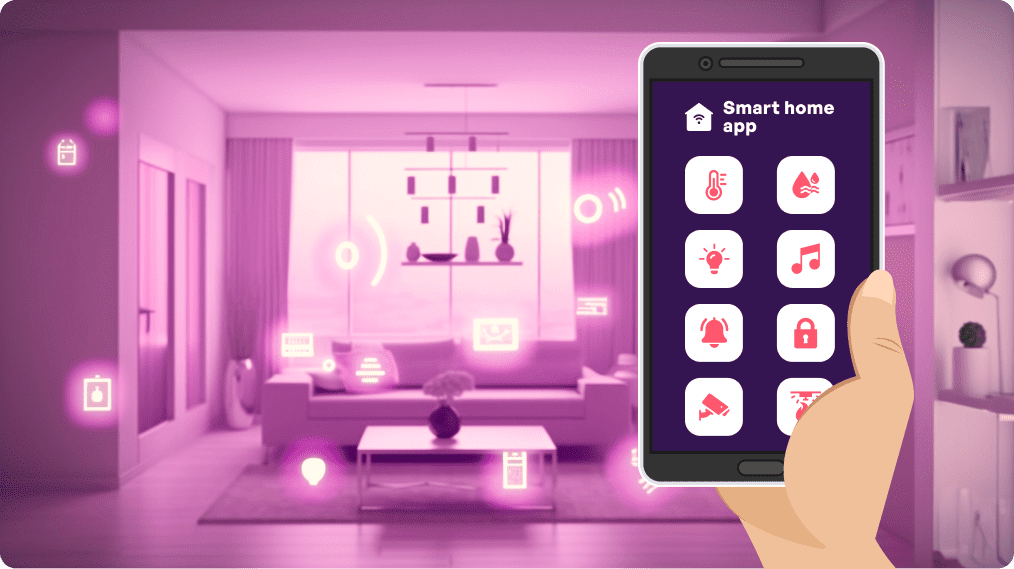 Businesses can maximize the technology to prove how their products, blended with innovation, can offer a truly intelligent home experience. It eases controlling various home aspects for a safe, favorable, and luxurious lifestyle while building immense trust with data privacy. Put together, building smart home apps paired with IoT development services can attract and retain consumers to skyrocket business gains. Let’s see examples.
Businesses can maximize the technology to prove how their products, blended with innovation, can offer a truly intelligent home experience. It eases controlling various home aspects for a safe, favorable, and luxurious lifestyle while building immense trust with data privacy. Put together, building smart home apps paired with IoT development services can attract and retain consumers to skyrocket business gains. Let’s see examples.
Apple had launched its first-gen HomePod (high-fidelity speakers) in 2018 that registered a sale of a whopping 13.5 million in 2022 which further encouraged the tech giant to launch the second-gen in February 2023. Other top-notch companies leveraging home automation apps for profits include LG (ThinQ), Amazon (Alexa), and Google (Google Nest).
If you too wish to penetrate the market with home automation services, let’s understand the basics first and then how to get started with smart home app development.
Table of contents
What is smart home automation?
Home automation refers to using internet-based gadgets to control systems round the clock with a few taps on an app rather than doing it manually. This is typically available within a single application for all electronics to avoid constant switches.
Given these benefits, more than half of US consumers are expected to adopt smart home technology by 2025. Since consumers are reportedly shifting towards a pragmatic approach to manage their homes, rest assured that it is a good idea to invest in this venture to see promising profitability.
Below is a basic idea of the unified functionalities smart home automation solutions can help achieve:
- switch on and turn off lights and fans
- control the HVAC for heating and cooling
- operate washing machines, ovens, kettles, fridges and TVs,
- lock and unlock doors and windows with biometrics
- fire, gas leaks, or water wastage detection
- sensors for gardening to monitor soil, sun, and water levels
- track general opening and closing actions in the house
Businesses can tap on these and build apps for various types of smart home devices, sync their usage and thus cater to the evolving efficiency and security needs of customers. Ultimately, this aids in boosting competitive edge, the end-results of which are seen in the ROI.
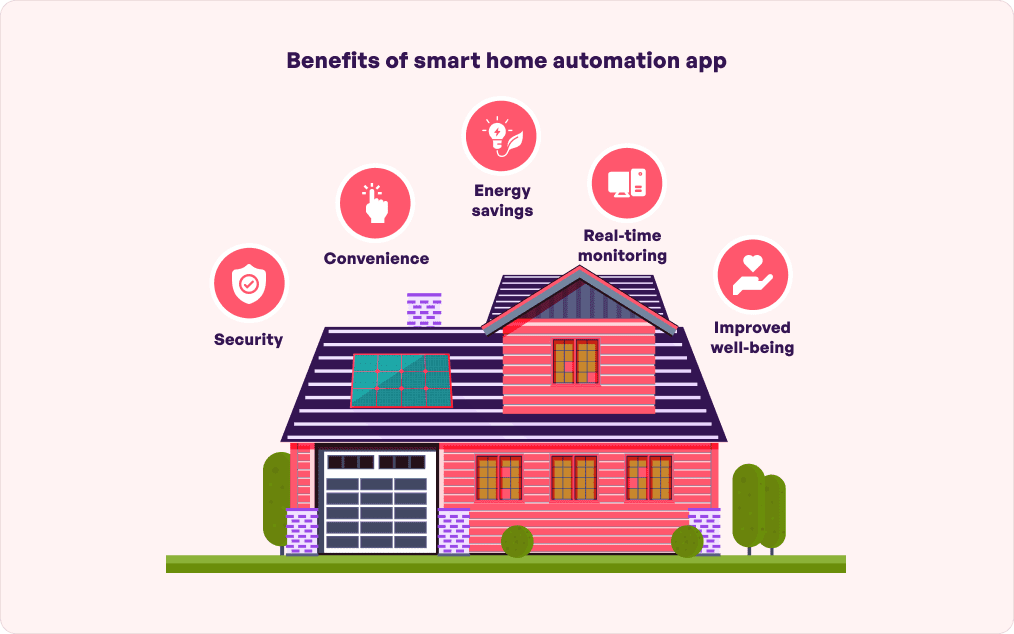 In fact, the increasing demand from consumers for an interactive environment plus the growing adoption of automation technology has led the global smart home automation market size to grow at a 27.3% CAGR growth between 2023 to 2030. So, it is a fantastic opportunity for brands to consider penetrating this lucrative smart home space to make money.
In fact, the increasing demand from consumers for an interactive environment plus the growing adoption of automation technology has led the global smart home automation market size to grow at a 27.3% CAGR growth between 2023 to 2030. So, it is a fantastic opportunity for brands to consider penetrating this lucrative smart home space to make money.
What are the components of smart home automation apps?
Smart home apps use communication protocols like Z-Wave or bluetooth to link the below three components:
Hub: This is the signal center or the ‘brain’ of the app which unites individual IoT gadgets around the home and helps them respond, communicate and work together. They are connected either via cloud or locally and enhance convenience.
Sensors: This device alerts users for any changes in the home status via wireless technology to help make informed decisions. However, these need to be set up for specific triggers to work efficiently. For instance, lights should illuminate when there are step vibrations from footsteps when walking at night.
Actuators: These are electromechanical devices that change energy into physical motions as per the commands received from the hub. For instance, curtain blinds are closed or objects like a vacuum cleaner can be moved around the home.
The next section tells you how we at Simublade, a top mobile app development company, can help you get started with building a smart home app.
Simublade’s smart home app development process : a step-by-step breakdown
Home automation has three components: monitoring, control, and automation which are integrated in a friendly application by our dedicated IoT developers to elevate living standards. The team does this by connecting multiple sensors to smart home gadgets along with hack-proof encryption to build revolutionary solutions. All of these are backed by powerful tool sets, precision and creativity, and tried and tested next-gen tech stacks. Now, let’s explore the smart home automation app development process in detail.
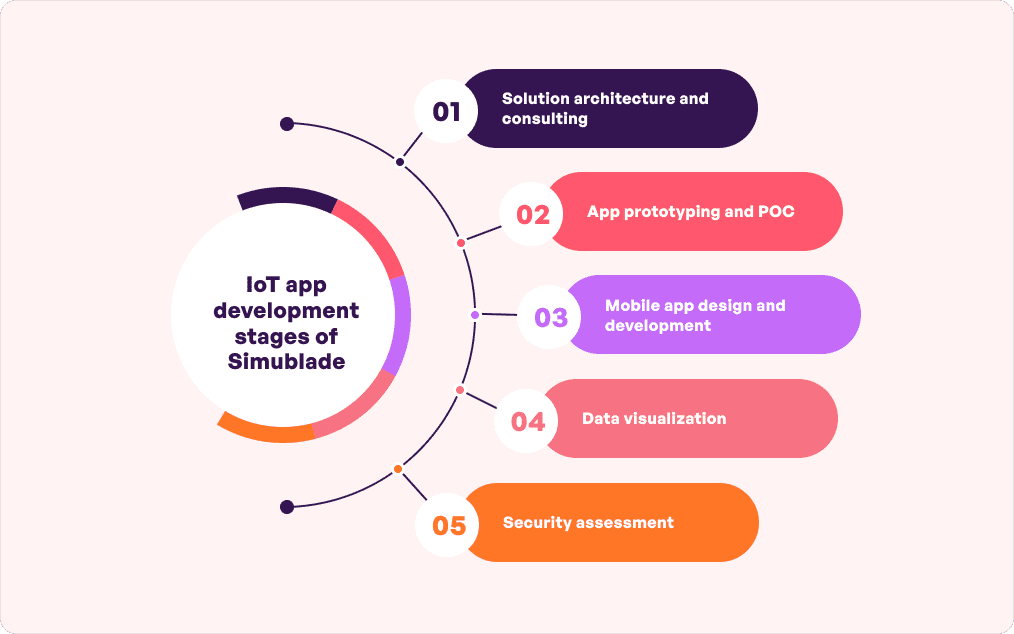
Stage 1: Solution architecture and consulting
Right from conceptualization to deployment, our IoT developers will offer a walk-through to businesses for transparency and clarity. Then they build an accurate solution architecture which is highly personalized to specific needs.
Stage 2: App prototyping and POC
Our rapid prototyping capabilities speed up the market validation timeline. This is made possible since the designers and developers join hands to build custom prototypes that present a tangible product experience. Stakeholders like business partners and investors can then offer valuable feedback which are also deployed successfully.
Stage 3: Mobile app design and development
Simublade’s USP is to build designs that are in sync with customers’ needs to ensure organic-level experience. Our experts start working on the application after receiving a green signal from you. The result is seamless connectivity and impressive analytical abilities.
Stage 4: Data visualization
ML and predictive analytics are used to gather customer data and insights to address pain points. This helps businesses get a better understanding of the preferences, attitude and behavior of the target audience for operational efficiency.
Stage 5: Security assessment
Our developers strive to remove unforeseen threats and vulnerabilities via extensive testing which is a top priority of our IoT application development services. It helps eliminate risks in the application which is necessary for smooth operations.
Besides smart home solutions development from scratch, Simublade also offers IoT cloud integration, wearable connectivity, security assessment, and penetration testing. So, businesses across all sectors like fintech, retail, health, and travel in the USA and Saudi Arabia partner with us to see a radical improvement in brand value.
What are the smart home app development costs?
Building smart home apps can cost between $20,000 and $150,000 depending on the app’s concept, IoT architecture, number of connected networks and devices, platforms, and the development team’s size, location, and expertise. Let’s have a look in detail.
Low complexity app
iOS – $10,000 to $15,000
Android – $12,000 – $18,000
Cross platform – $10,000 to $15,000
Medium complexity app
iOS – $15,000 to $20,000
Android – $18,000 to $25,000
Cross platform – $15,000 to $25,000
High complexity app
iOS – $20,000 to $25,000
Android – $25,000 to $50,000
Cross platform – $25,000 to $50,000
Technologies used in a smart home automation app
IoT tech stack for smart home application development includes 4G, 5G, Bluetooth, WiFi, Beacon, Modbus, HTTP, HTTPS, Sigfox, AWS IoT, Zigbee, and MQTT. Machine learning and artificial intelligence are also integrated to help your users build a seamlessly connected cozy sanctuary for themselves.
Further, both frontend and backend components like web frameworks, programming languages, API integration, user authentication, database management systems, cloud services, and real-time communication are leveraged for clean user experience.
Top 10 features of reliable smart home apps
The best-in-class developers craft exciting features with advanced technologies to help customers set up a home to their liking. Here’s a look at what the ideal app should offer.
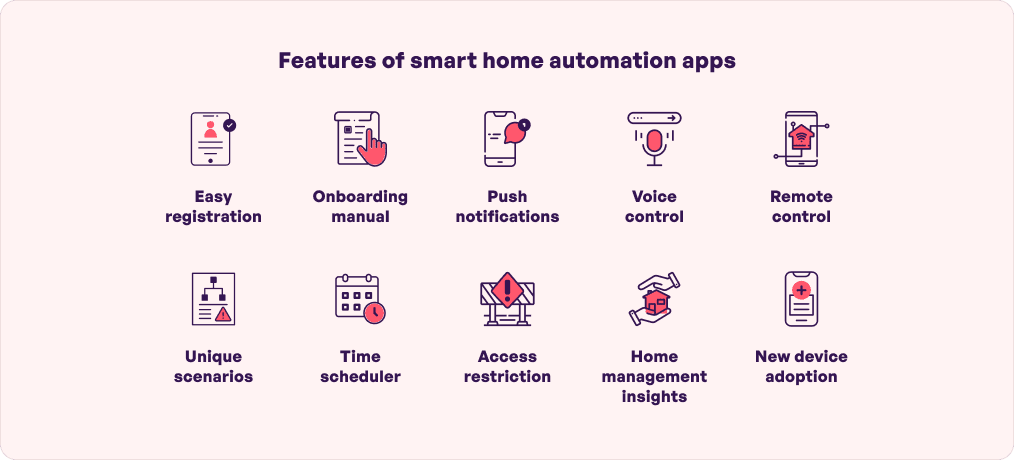
- Easy registration: Users must be able to register quickly and securely with Google accounts or social media sites like Facebook.
- Onboarding manual: Clear and straightforward instructions regarding how to set up systems must be added to help users maximize the benefits of smart home automation.
- Push notifications: Well-configured notifications are essential to keep the user informed about multiple systems in the home. They should also have the flexibility to customize notifications to separate useful features from less-essential ones.
- Voice control: It must be integrated for a hands-free experience Siri and Alexa to enhance user satisfaction.
- Remote control: This is necessary to ensure all types of smart home devices are easily accessible with a tap or voice command from different locations.
- Unique scenarios: Users should be allowed to set up scenarios like Movie Night where lights are automatically dimmed, the projector is switched on, and the AC is adjusted to a comfortable temperature.
- Time scheduler: A smart app must be useful in automating everyday tasks like laundry or temperature regulation and stop when certain conditions are met.
- Access restrictions: An automation app must be equipped with specific user-access as per their age and role. For instance, children must be limited from opening smart locks but can be allowed to switch on lights.
- Home management insights: Users must be able to track their energy consumption and appliance usages to ensure the best practices to modify their lifestyle.
- New device adoption: The app should be designed in a way that it is easily compatible with new devices when the old ones are discarded. It is a fantastic way to support users in upgrading their home appliances without hiccups.
Smart home automation app: challenges and solutions
IoT apps, like any other solution, face a few technical glitches which can be identified and rectified by our adept developers at Simublade. Read on to find out.
Interoperability
Connecting multiple appliances to the internet to enjoy real-time features might cause interoperability gaps in terms of mechanisms, technologies, and protocols. However, this can be sorted by adding new software and IoT stack that make way for easy data flow. A few standard protocols like CoAP or MQTT can also be integrated to resolve the issue.
Security concerns
IoT devices are prone to development code susceptibility which can cause unauthorized access. If not discovered on time, the threats and vulnerabilities keep piling up leading to crippled network infrastructure. Developers handle this by ensuring robust cybersecurity services like encryption, data anonymization, IMEI locks, and authentication. However, these require heavy power consumption which can be made possible with :
- adjusting sensor sampling rates
- using energy-saving hardware
- reducing hefty data transmissions
- suggesting low-power modes to users
Further, IoT devices, cloud, and backend stack are checked and updated regularly. Audits and patches are also a part of smart home application development along with powerful security portals between architectural components to prevent hacking.
Short battery life
The push for smaller IoT devices are on the rise to cater to ‘low-profile’, style, compactness, and portability along with the need to protect against harsh weather conditions. Small-sized devices are typically launched as and when technology progresses, like the advent of multi-radio inferences, which reduces the battery lifespan. However, this is navigated by hardware and software optimization and using network technologies like LTE-M and NB-IoT which can extend the battery life up to 10 years, if not more.
Network connectivity
It is obvious that IoT devices will malfunction without strong WiFi and bluetooth. There are fewer chances of loading real-time data which compromises the features and functionalities. The good news is that technologies like Sigfox and LPWANs, typically used by our developers at Simublade, help the IoT products function within the range of a few miles without glitches.
Regulatory compliance
Having a mobile application that is aligned to the state and federal compliance regulations is mandatory. This is especially necessary when integrating AI in software development to prevent legal and ethical implications.
Working with highly experienced developers will help your business stay safe since they have a comprehensive idea of the guidelines and design the app accordingly.
Conclusion
With IoT-powered smart home automation apps, tangled wires and bulky devices are a thing of the past. Further, the integration of AI and ML technologies has made sure that electrical gadgets can recognize gestures, shapes, and sound in a refined way. The best part is that adding intelligence to physical objects, which is a big leap in technology, is translated to healthcare and other critical industries as well.
Moreover, children, pets, and seniors can enjoy high-quality well-being since the home environment changes as per pre-decided settings rather than the need to make adjustments traditionally. This wide audience base – ranging from both commercial and personal use – is what is directly increasing the attention the technology is getting from entrepreneurs.
Ultimately, considering smart home app development means offering security, comfort, and immense peace of mind to your customers along with plenty of time to focus on creative human-centric tasks, rather than the routined ones, to let them live a productive life.
FAQs
Q. What is smart home automation?
Ans. Smart home automation means using internet-connected devices to control and manage different appliances and systems in a home. For instance, automatic heating and cooling or security locks with remote or voice commands.
Q. How much does it cost to develop a home automation app?
Ans. Smart home app development cost is between $20,000 and $150,000. It depends on the app complexity, features, platform, technologies, and the location and expertise of the development team.
Q. How to ensure security for a smart home app?
Ans. Encryption, authentication, data anonymization, strong passwords, regular updates, and secured WiFi networks are top security measures for smart home apps.
Q. How does a smart home app work?
Ans. Smart home apps are made up of components like a hub, sensors, and an actuator. These are interconnected to one another via communication protocols to understand commands and respond accordingly.
Q. How Simublade can help you make a smart home automation app?
Ans. Simublade has a dedicated team of in-house IoT engineers who offer IoT solutions and architecture consulting, prototyping and POC, IoT app design and development, data visualization, and security assessment which altogether helps create a market-ready app.
Q. How long does it take to develop a smart home automation app?
Ans. The standard timeframe to develop a smart home automation app is between 3 to 6 months. Everything, from ideation to planning, and deployment, is included in this.


